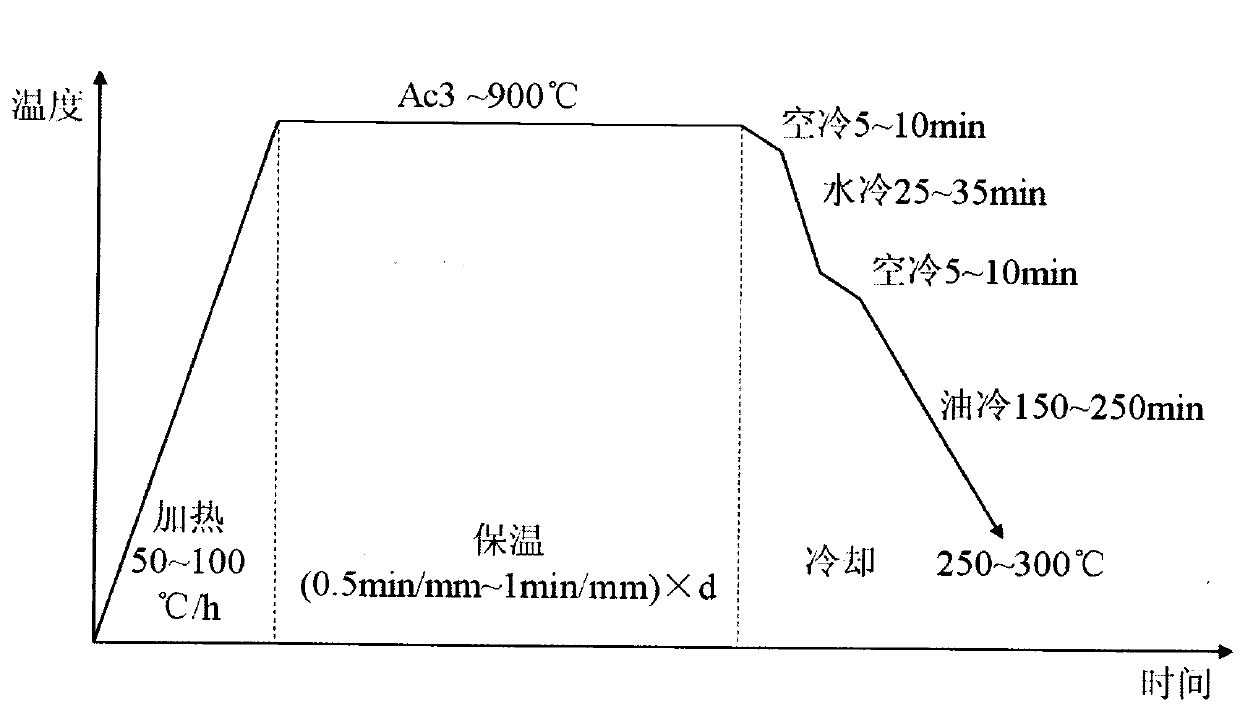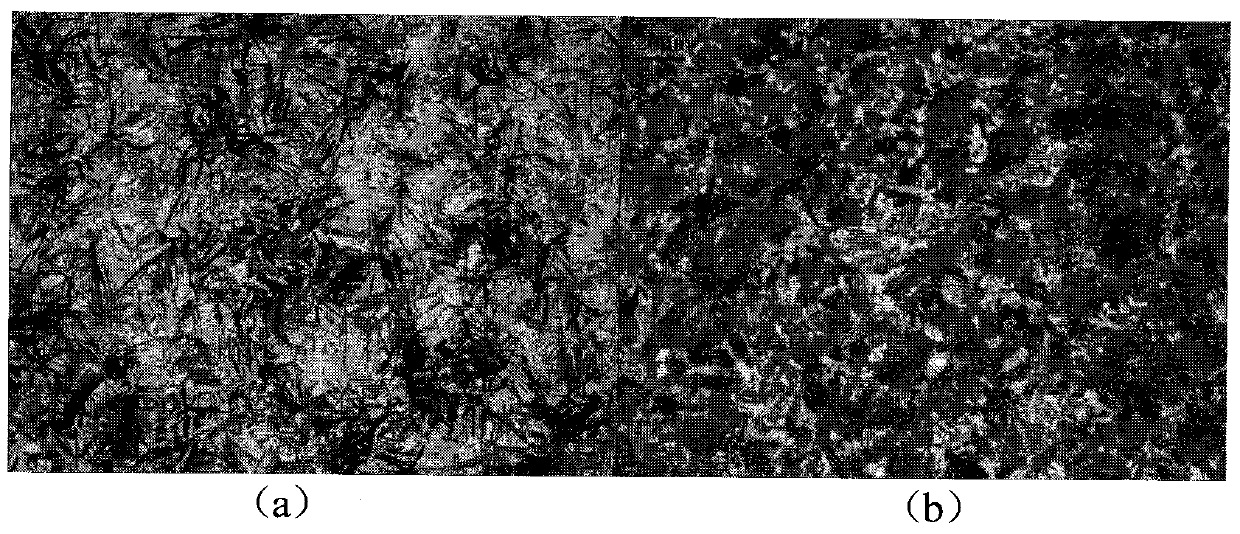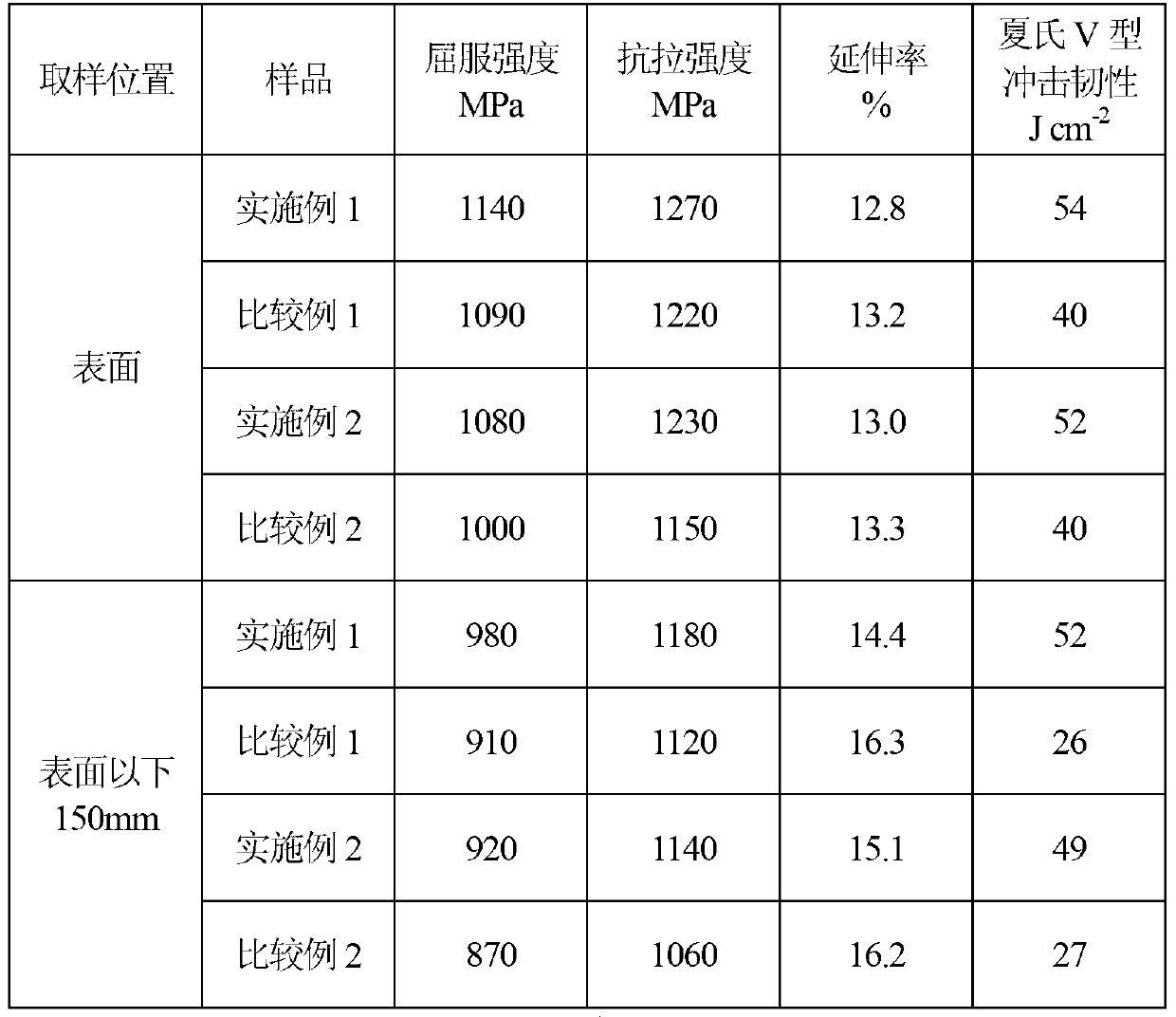Quenching heat treatment process for hot work die steel with low heat resistance
A technology of hot work die steel and heat resistance, which is used in manufacturing tools, metal processing equipment, forging/pressing/hammer devices, etc. It can avoid the deformation and cracking of quenching heat treatment, improve the comprehensive mechanical properties, and achieve the effect of high cooling rate.
- Summary
- Abstract
- Description
- Claims
- Application Information
AI Technical Summary
Problems solved by technology
Method used
Image
Examples
Embodiment 1
[0024] The weight of the smelted and poured steel ingot is 140t. After two upsetting and elongating processes, it is processed into a mold steel with a size of 3000mm×1000mm×800mm. After chemical analysis, its specific composition is shown in Table 1.
[0025] Table 1 *Chemical composition of low heat resistance hot work die steel in Example 1 (weight percent, %)
[0026] the element
C
Si
mn
P
S
Cr
Mo
Ni
V
Composition specification
0.4~0.6
0.1~0.5
0.6~1.0
≤0.01
≤0.01
0.9~1.3
0.4~0.6
1.4~2.0
0.06~0.1
Measured ingredients
0.54
0.20
0.74
0.008
0.005
1.06
0.48
1.58
0.086
[0027] *Ac of this ingredient 3 It is 715°C.
[0028] The quenching heat treatment process for low heat resistance hot work die steel is as follows:
[0029] 1) Heating: Heating at a slow heating rate of 80°C / h to the austenitization temperature of low heat-resistant hot wor...
Embodiment 2
[0034] The weight of the smelted and poured steel ingot is 215t. After two upsetting and elongating processes, it is processed into a mold steel with a size of 3800mm×1500mm×1300mm. After chemical analysis, its specific composition is shown in Table 2.
[0035] Chemical composition of low heat resistance hot work die steel in Table 2 Example 2 (weight percent, %)
[0036] the element
C
Si
mn
P
S
Cr
Mo
Ni
V
Composition specification
0.4~0.6
0.1~0.5
0.6~1.0
≤0.01
≤0.01
0.9~1.3
0.4~0.6
1.4~2.0
0.06~0.1
Measured ingredients
0.45
0.35
0.85
0.005
0.005
1.20
0.55
1.70
0.07
[0037] *Ac of this ingredient 3 It is 760°C.
[0038] The quenching heat treatment process for low heat resistance hot work die steel is as follows:
[0039] 1) Heating: Heating at a slow heating rate of 50°C / h to the austenitization temperature of low heat-resistant hot work...
experiment example 1
[0056] The low heat-resistant hot work die steels in Examples 1 and 2 and Comparative Examples 1 and 2 were sampled respectively at the surface position and the position about 150mm below the surface, and the mechanical properties were measured. The specific values are shown in Table 3 .
[0057] The mechanical performance detection of the embodiment of the present invention and comparative example of table 3
[0058]
[0059] As a result, it can be seen that the strength performance and impact toughness of the samples in Examples 1 and 2 are significantly better than those of the corresponding samples in Comparative Examples 1 and 2, and there is no low resistance in Examples 1 and 2. Hot hot work die steel has severe deformation and quenching cracking. It shows that the invention achieves the purpose of improving the mechanical properties of the material.
PUM
| Property | Measurement | Unit |
|---|---|---|
| size | aaaaa | aaaaa |
| thickness | aaaaa | aaaaa |
Abstract
Description
Claims
Application Information
 Login to View More
Login to View More - R&D
- Intellectual Property
- Life Sciences
- Materials
- Tech Scout
- Unparalleled Data Quality
- Higher Quality Content
- 60% Fewer Hallucinations
Browse by: Latest US Patents, China's latest patents, Technical Efficacy Thesaurus, Application Domain, Technology Topic, Popular Technical Reports.
© 2025 PatSnap. All rights reserved.Legal|Privacy policy|Modern Slavery Act Transparency Statement|Sitemap|About US| Contact US: help@patsnap.com



